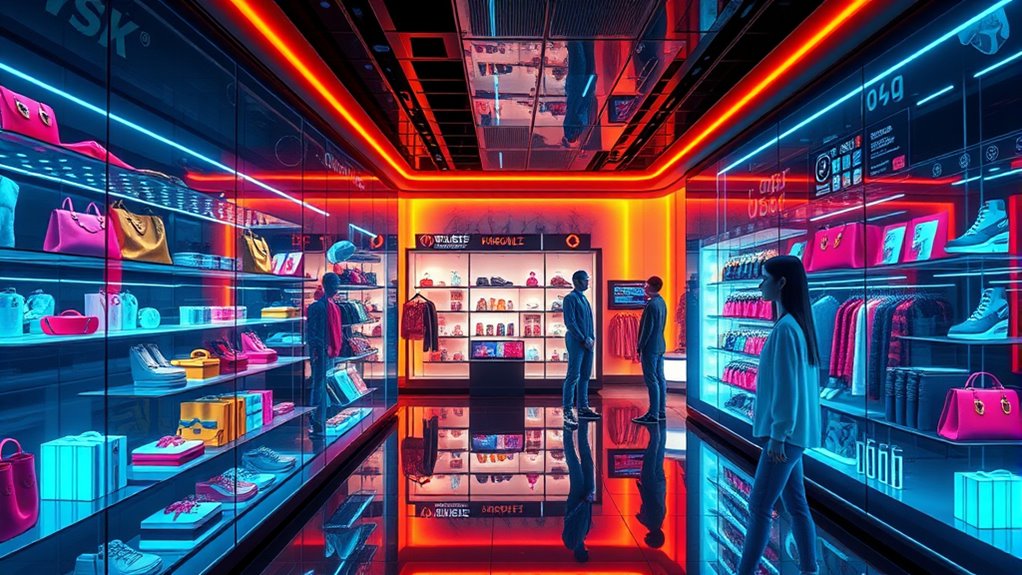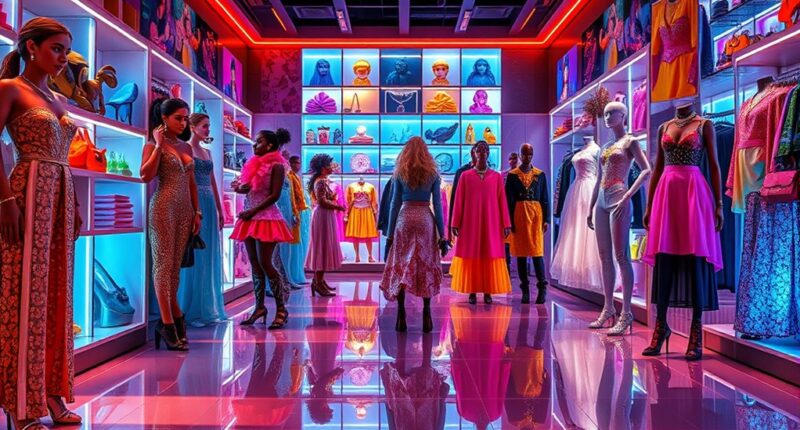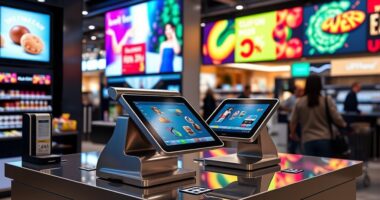Retail is shifting into an immersive simulation where AI, avatars, and endless customization transform your shopping experience. You’ll encounter virtual shopping assistants, personalized product suggestions, and virtual try-ons that feel lifelike. Physical stores are becoming entertainment hubs, blending online and offline worlds seamlessly. With AI-driven insights and avatars, your preferences are anticipated and catered to like never before. If you keep exploring, you’ll discover how these innovations can reshape your entire retail journey.
Key Takeaways
- Retail is adopting digital simulations powered by AI to create immersive, personalized shopping experiences.
- Avatars and virtual assistants guide customers, offering customized product recommendations and support.
- Generative AI automates routine tasks, enhancing efficiency and enabling endless product customization options.
- Omnichannel data integration allows for seamless, hyper-personalized interactions across online and offline channels.
- Retailers leverage avatars, AI, and simulations to transform physical stores into engaging, entertainment-driven environments.

As retail transforms through advanced technology, businesses are increasingly entering a digital simulation that reshapes how they operate and engage with customers. This new landscape is driven by AI-powered tools that integrate various functions into unified platforms, often through retail superapps. These superapps serve as the nerve center of operations, combining training, communication, and execution into seamless workflows. You can think of them as the cockpit from which all retail activities are managed, simplifying complex processes and boosting efficiency. AI is not just an add-on anymore; it’s becoming the core operating system, managing store execution, workforce enablement, and customer interactions with high precision.
Generative AI is revolutionizing how retailers handle product data, customer experiences, and automation. It enables you to enhance product descriptions, improve visual content, and automate routine tasks, freeing your team to focus on strategic initiatives. Autonomous store technologies, like Amazon Go, remove friction at checkout by utilizing sensors and computer vision, allowing customers to walk in, pick what they want, and leave without stopping at a register. This innovation dramatically boosts convenience and reduces wait times, creating a frictionless shopping experience. AI-driven personalization has become the baseline expectation, with algorithms analyzing customer data to predict preferences and tailor recommendations. You’re empowered to deliver highly relevant suggestions, increasing engagement and sales.
AI-driven recommendations analyze customer behavior in real time, offering personalized product suggestions that feel intuitive and relevant. Virtual shopping assistants, supported by generative AI, help guide customers through their journey, answering questions, and providing tailored advice. AI agents can autonomously perform tasks such as managing inventory, updating product listings, and handling customer service inquiries, reducing manual workload and speeding up response times. Retailers leverage AI to create personalized experiences, like virtual makeup trials or customized product bundles, making each interaction unique and memorable. Integrating online and offline data provides a complete view of customer preferences, enabling a truly omnichannel approach.
Emerging trends like retail media networks harness customer data for targeted advertising, turning shopping environments into engaging, monetized platforms. Immersive shopping experiences, such as retailtainment, transform physical stores into destinations that entertain and attract visitors. AI analytics optimize operations, increasing sales and profits by fine-tuning everything from inventory levels to promotional strategies. Modern commerce systems focus on seamless customer interactions, blending physical and digital touchpoints. Customer engagement elevates through curated interactions driven by AI, fostering brand loyalty. Social influencers and AI-powered loyalty apps further personalize rewards, boosting retention. Facial recognition technology enhances in-store experiences with personalized offers, creating a feeling of exclusivity and attentiveness.
Operational efficiency benefits immensely from AI, especially in inventory management and demand forecasting. Predictive analytics reduce stock shortages and overstocking, aligning supply with demand precisely. Automated tasks like data collection and product listing free up staff to focus on customer service and strategic growth. AI ensures operational consistency, streamlining processes across the board, all while delivering significant cost savings. The retail landscape is no longer just physical or digital—it’s a simulation where AI and customization open endless possibilities, transforming retail into an immersive, personalized experience for every customer.
Frequently Asked Questions
How Secure Is Personal Data in Retail Metaverse Environments?
Your personal data in retail metaverse environments isn’t fully secure yet. While platforms use encryption and security protocols, vulnerabilities still exist, especially around unauthorized access and data breaches. Biometric and financial information are prime targets, and inconsistent global regulations make compliance tricky. To stay protected, you should be cautious with what data you share, look for platforms that prioritize transparency, and advocate for stronger security standards in virtual retail spaces.
Will Traditional Online Shopping Still Exist Alongside Virtual Stores?
Like a bridge spanning two worlds, traditional online shopping will still exist alongside virtual stores. You’ll find both channels thrive because each offers unique benefits—convenience and tactile interaction. As your preferences evolve, you’ll switch seamlessly between them, enjoying personalized digital experiences or the social vibe of physical stores. This coexistence guarantees you get the best of both, adapting to your needs and making shopping more flexible and engaging.
Can Small Retailers Afford to Adopt Simulation-Based Retail Technologies?
You probably can’t afford to adopt simulation-based retail technologies easily due to high initial costs, ongoing expenses, and limited digital literacy. Small retailers often rely on government grants or partnerships to offset these costs. While the potential productivity and customer engagement benefits are significant, the upfront investment and longer ROI timelines make it challenging without external support or scalable solutions tailored for small businesses.
How Do Virtual Try-Ons Impact Physical Product Sales?
Imagine a shopper standing before a mirror that shows not just their reflection but a world of possibilities. Virtual try-ons boost your sales by helping customers see how products fit and look, making them more confident and likely to buy. This reduces hesitation, increases order value, and cuts down returns. Ultimately, virtual try-ons turn your store into a dynamic, immersive experience, encouraging customers to buy more and shop more often.
What Are the Environmental Impacts of Large-Scale Virtual Retail Spaces?
You see that large-scale virtual retail spaces can considerably reduce environmental impacts by cutting down on shipping, packaging, and returns. However, they still consume energy through data centers, servers, and digital infrastructure, which contributes to carbon emissions. If you don’t manage these resources efficiently, the environmental benefits diminish. Overall, virtual spaces offer opportunities to lower emissions but require sustainable practices to truly minimize their ecological footprint.
Conclusion
As you step into this digital retail landscape, it’s like entering a vibrant, endless playground where avatars and AI are your guides. With endless customization options, the virtual world becomes a mirror of your imagination, transforming shopping into an immersive adventure. This new frontier is a tapestry woven with innovation, inviting you to explore, personalize, and redefine what retail can be—an ever-evolving universe where your preferences shape the experience.









